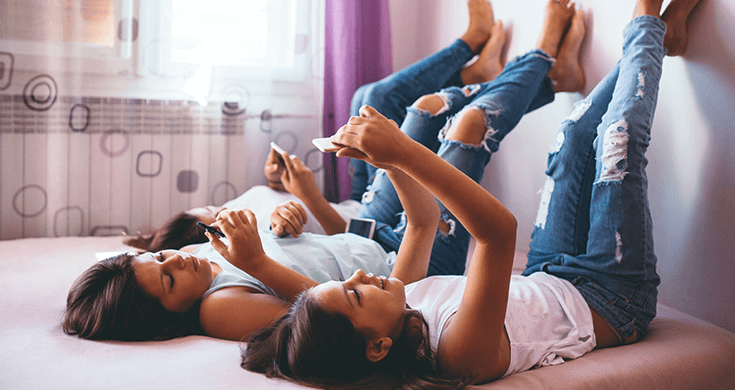With one billion active monthly users, Instagram is one of the most popular social media networks available to teens today. In fact, 72 percent of teens have an active Instagram account. But what exactly do kids do on Instagram, and should you be monitoring your child’s activity?
What Is Instagram?
Instagram, which is now owned by Facebook, is a social media network application that allows users to upload and share photos and videos to their feed of followers. Part of Instagram’s appeal is its filters, which allow users edit and tweak their images to fit a certain mood or visual aesthetic.
Many teens use Instagram to connect with friends and family. However, it is also a platform for engaging with celebrities, brands, and media influencers.
Is Instagram Safe for Kids?
Although Instagram can be used in many positive ways, there are significant risks to your child that all parents should be aware of. Some of these risks include:
- Distractions: Social media apps, including Instagram, can be very distracting to children and teens who use their cell phones at school and, as a result, are often responsible for disrupted class time.
- Anxiety: Many Instagram users—especially brand influencers—are known for their perfectly posed and edited photos of lavish vacations, festivals, or adventures. The line between reality and what is posted on social media is often blurry. Although some reports suggest Instagram will see a shift from influencers portraying an “idealized” life to a more realistic one, teens often find it impossible not to compare their appearance, belongings, status, and lifestyle to the lives of those they follow. It is so easy for a child to become consumed by this constant comparison. In fact, research shows that it can lead to severe self-esteem issues and anxiety.
- Privacy: All social media users—but especially children and teens—risk sharing too much personal information online. If your child has gathered a large Instagram following or does not have privacy settings turned on, shared information may be public for all to see.
- Bullying: In one study, 27 percent of surveyed teens cited bullying and rumor spreading as the main reason they have a negative view of Instagram. Cyberbullying can put a heavy strain on your child’s mental health, often leaving them depressed or angry. Additionally, 69 percent of teachers believe phones and mobile devices are mostly harmful to students’ mental health due to cyberbullying and digital self-harm.
- Content: Instagram utilizes a feature called “Explore” where users can browse popular public images and videos posted by people outside of their personal feed. Although content curated in your child’s Explore feed is tailored toward their browsing history and interests, it is possible they could stumble across potentially inappropriate subject matter.
What Is Finstagram?
Finstagram, or Finsta, is a term coined to represent your teen’s second Instagram account. The “F” in “Finstagram” stands for “fake.” You are probably asking yourself, “But what is Finsta? Why would anyone need two accounts?”
As mentioned, Instagram has become the go-to place for posting heavily filtered snapshots and perfectly curated images that may or may not represent one’s actual, everyday lifestyle.
Recently, many Instagram users—especially teens and young adults—have turned to their Finstagram accounts to express a more authentic side of their personality without sacrificing the look and feel of their main Instagram account. If your child has a Finsta, their feed is probably filled with more candid, less edited selfies and fun pictures with their friends.
How Can Parents Monitor Instagram?
Feeling concerned or worried about your child spending too much time on Instagram is understandable. Rather than banning your child from the platform entirely, you might consider the following:
- Set screen-free time: When a child spends too much time viewing life through the images of others, they can forget to take the time to truly live their own life. Rather than enjoying and tangibly experiencing things like vacations, parties, and life milestones, it is easy for users to begin viewing life as a series of Instagram-worthy pictures and clever captions. Encourage your child to incorporate plenty of screen-free and Instagram-free time into their daily lives.
- Set an example: One of the best ways you can influence your child to develop a healthy relationship with social media is by demonstrating one yourself. Set aside your own screen-free time each day and refrain from vocalizing any negative self-comparison.
- Have open conversations: It is crucial that, as a parent, you understand your child’s social media presence and have open and honest conversations about the dangers of self-comparison and oversharing on Instagram. Make sure you are checking in with your child frequently and asking questions about their life, both online and offline. Share your concerns with them and listen to their thoughts so you can work together on a strategy for approaching social media.
- Know when to intervene: If you notice your child is constantly experiencing the adverse side effects of Instagram—despite your best efforts—take the steps necessary to protect your child, their mental health, and their privacy. For some, this may mean locking the app on your child’s phone until a compromise can be reached.
Like most social media platforms, if used correctly, Instagram can be a fun way for your child to stay engaged and connected with friends and family. Work together to foster a healthy relationship with Instagram and encourage positive social media behavior.




































